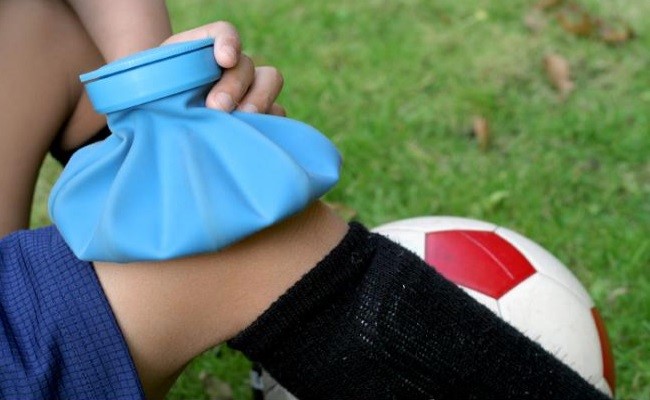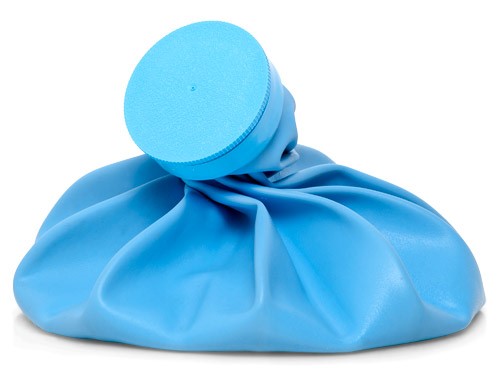Applying ice is one of the most effective ways to reduce pain. However, it is important to emphasize that it has no therapeutic effects, but rather is an analgesic agent. This means that the cause of pain is not treated or eliminated. It can be used in replacement of a drug such as ibuprofen. Simply, it is useful for pain relief and achieves rapid aid, especially in medical conditions that are chronic and evolve with inflammation.
How Does Ice Help Injuries?
When an injury occurs in our body, the inflammation process is triggered. This is a normal response that aims to promote healing. Inflammation is always accompanied by pain, swelling and redness, especially in the area of the affected tissue. Pain is caused by compression of the damaged parts. This process involves a series of natural reactions in order to promote healing of the affected tissue.
Then, how does ice help injuries? Ice acts as a supplier of cold, causing numbness or decreased sensibility locally. Ice causes vasoconstriction and the passage of blood is reduced. This fact leads to a decrease of pain and swelling because liquid accumulation is reduced.
On the other hand, the action of cold on the injured area causes a decrease in muscle contractions and this leads to pain reduction. In this way, ice works by reducing pain, swelling and inflammation. Applying ice does not treat the cause of the injury, but acts on the processes associated with it.
When to Use Ice?
Ice can be applied in case of acute or "fresh" injuries such as sprains, contractures, and other muscle issues. When the skin is injured, then the problem is a bit more serious. When you get injuried, the inflammation is sure to last for some days. Fresh injuries are those that are still tender to touch, red and hot and swelling. When this happens, heat application should be avoided and ice be applied in order to reduce blood flow to the area and promote the immune response.
Ice application is not only useful in acute injuries. Certain chronic medical conditions can also benefit from the ice application. Such is the case of medical issues associated to muscle overuse such as carpal tunnel syndrome, tendinitis, cramps, plantar fasciitis.
Certain types of arthritis (joint inflammation) such as rheumatoid arthritis and ankylosing spondylitis can be relieved by applying ice, too.

Tips for Applying Ice
- Apply ice immediately. Do not wait more than 5-10 minutes. The application should not last more than 20 minutes to generate the desired effects.
- Repeat this process every two or three hours for the next 24 or 48 hours. It is not necessary during sleeping hours. After 48 hours, control of bleeding and swelling are no longer the objectives; but rather re-mobilize the affected area. How does ice help injuries then? At this stage, the application of ice will provide relief to the affected muscle.
- Do not apply ice directly, but rather wrapped in a towel or canvas.
- It is advisable to leave a break between each application so that the affected area is restored and can better exploit the effects of ice on each application.
- Ice should not be applied in areas with circulatory or lymphatic problems.
How to Apply Ice Packs

Ice packs can be prepared from ice cubes placed inside a plastic bag or flannel or wet towel. Another way to apply ice is using a package of frozen peas. However, it is important to remember that if peas are used, they should not be left for consumption. Or you can buy some well-prepared ice packs from pharmacies.
How Ice Packs Are Used?
First, it is appropriate to apply oil and rub it on the area where the application will be performed. You do not need to use an essential oil. Any neutral oil, as one of sunflower or corn, can be used. If a suture has been made, you should not put anything over it, but rather to protect it with a bag to prevent wetting the wound.
- Place a towel or damp cloth over the wound area. This is not necessary in the covered area with the bag.
- Apply the ice pack on the towel.
- Wait 5 minutes and confirm the condition of the wound. If it is no longer red or deep pink, you can remove the ice. Otherwise, wait about 5 minutes.
- Redo the same procedure until the skin is no longer red. Avoid leaving the ice pack on the skin for more than 20 minutes. This will not bring any additional benefit and may even be counterproductive.
Finally, how does ice help injuries? Benefits of ice application can be improved when a light pressure is exerted on the area.
Note: Ice can generate counterproductive effects if you do not have proper protection like a wet towel or the correct application of oil. Both are a form of insulation that protects against excessive cold.
